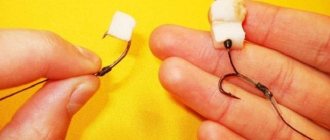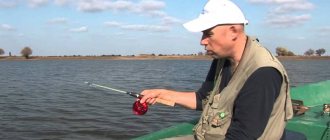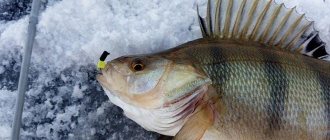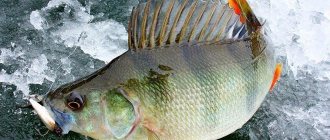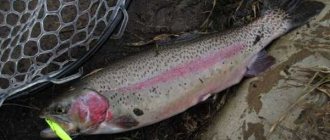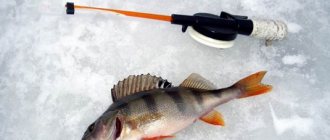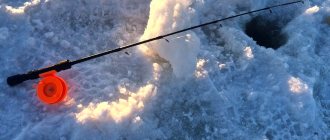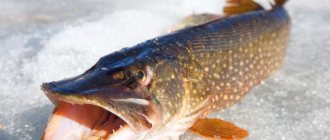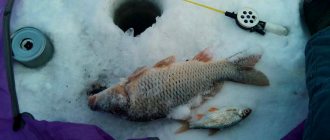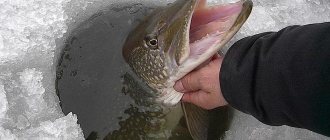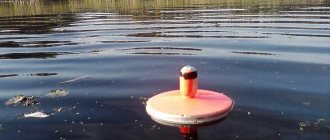Description and lifestyle
Bleak Bleak
(Alburnus alburnus), a freshwater schooling fish of the carp family. Length up to 20 cm, weighs up to 60 g. Mouth is terminal, scales easily fall off. The back of the bleak is bluish-gray, with a green tint. The sides and belly are yellow, shining with silver. Fins are gray. The body is long, compressed, with a sharp rib on the abdomen. The upper jaw of the bleach has a recess into which the lower jaw fits. Gill rakers are frequent.
This agile, fast fish is quite beautiful: its dark back with a greenish tint goes well with silvery sides and belly, the dorsal and caudal fins are dark, the anal and paired fins are yellowish or slightly reddish. In different habitat conditions, populations can be formed that are slightly different morphologically: in lakes and reservoirs, bleaks are usually larger, with a taller body, while in rivers they are smaller, with a more elongated body.
Bleak is not a long-lived fish; its life cycle is short, 5-6 years, and sexual maturity occurs already in the 2nd year of life. Bleak spawning is batchwise and begins at a water temperature of about 16 °C at the end of May, continuing in June, sometimes in July, with breaks of 10-15 days. During spawning, huge flocks of bleaks walk along the banks of reservoirs, laying eggs on grass, washed-out plant roots, sand near stones, and creating a lot of splashing and noise. At this time, the bleak completely loses its caution and a large number of it can even be caught with a net. The spawning process usually occurs on clear sunny days. It begins quite late in the morning, reaches its greatest intensity at noon and ends before sunset. This continues for 2-4 days until the next period (portion) of spawning. If the spring is warm, then spawning is limited to 2-3 stages, quickly following each other, but during periodic cold snaps it is extended due to the duration of maturation of the next portion of eggs. The overall fertility of bleak is very high. In one go, from 0.7 to 3 thousand eggs are spawned. In individuals 9 cm long and weighing 10 g, the absolute fecundity reaches 3.4 thousand eggs, with a length of 12.5 cm and a weight of about 18 g - up to 7.5 thousand eggs. The relative fertility of bleak is on average 250-400 eggs per 1 g of mass.
Incubation of the first portion of eggs lasts for 6-7 days, the next 3-4, as it occurs at high summer temperatures that are more favorable for it. The larvae remain almost motionless among the plants for the first days after hatching, then (after going through the first stages of development) they gather in schools and feed near the shores at the surface of the water, standing out among other small fish with their bluish back, slender thin body, and huge dark eyes on a narrow head. During the summer, fry of different stages of development are found in all reservoirs; by autumn they form into fingerlings. Despite the destruction of eggs and juveniles by many fish, birds, swimming beetles and other predators, the relative survival rate of bleak remains at a fairly high level.
Bleak, taking into account its maximum achievable size, grows quickly: by the end of the 1st year it reaches a length of 3-5 cm, weight - 6-7 g, by the 2nd year - length 6.5-9.5 cm, weight about 9 g , by the 3-4th year - length 10.5-12.5 cm, weight about 13 g. The largest individuals noted in the catches reached a length of 15 cm and a weight of about 30 g.
Bleak feeds from April to October, from the opening of reservoirs to frost. She is very voracious, intensively hunting for food from morning to evening with a short break at night. The food for bleaks in lakes and reservoirs is mainly zooplankton. As an adaptation to these conditions, it develops well-developed gill rakers on the gill arches, which help filter water and retain large quantities of small planktonic crustaceans. In rivers, the diet of bleak in the early stages of development is somewhat different - algae, rotifers, but even here it quickly masters larger food. Adult bleaks, along with zooplankton, readily consume mayfly larvae, small beetles, larvae of various insects, as well as adult insects caught from the surface of the water, and they are even given preference over other types of food.
The economic importance of bleak is small, although in lakes with high numbers it sometimes accounts for up to 6% of the total fish catch. Most often it is sold or processed as particulate fish mixed with other small species.
Habitats and catches
Bleak
- one of the most common, widespread and universally known fish. Inhabits the reservoirs of Europe from France to the east and north to the Northern basins. Dvina, Ural and Emba. Absent in Scotland and northern Sweden, and in Italy (south of the Alps and the Danube basin) and the Caucasus it gives way to other species and subspecies of bleak. In Russia, bleak is common in all rivers, lakes, ponds and floodplain reservoirs with clean water and a sandy bottom and is numerous everywhere.
Bleak distribution map
From early spring to late autumn, in open areas of reservoirs in clear sunny weather, large flocks of bleak can be observed at the very surface of the water. It is no coincidence that gulls, terns, loons and other water birds eat it more than other fish. All day, until dusk, the bleak is very active and is in constant movement, and only at night it rests almost motionlessly somewhere near the thickets or under overhanging coastal bushes and in places with a weak current. Bleak reacts very quickly to the appearance of other fish, especially predatory ones, trying to avoid meeting them, and yet this does not always save it from pike, perch, and especially from asp, for which these fish are a favorite food. For the winter, flocks of bleaks go to the depths, where they spend the entire cold season in wintering pits in a sedentary state.
When choosing a place to catch bleak
, first of all you need to focus on depth. Bleak loves deep places. Large bleak, rarely visits the coastal zone with a depth of less than 2 meters. The wind will also help you find the bleak.
The mounted fish tends to the leeward shore, in the calm formed by steep banks and trees, where wind-blown insects fall into the water. A school of bleak is not difficult to notice from the shore, since the fish feeding in the upper waters forms numerous stains on the water with its movements. In rivers, bleak avoids fast currents and prefers to stay in calm water and bays.
The bleak is easy to spot if you slowly approach the river bank or quietly swim across the lake. On the surface of the water it is enough to throw a handful of bait, a crust of bread, or a piece of polystyrene foam. A flock of perch immediately rushes to the fallen object, beginning to circle it along the water surface. With the onset of the cold season, the fish go to the depths, and in winter they again occupy their favorite upper horizons.
Catching bleak from ice
Fishing for bleak from ice in some places occurs all winter. This happens more often in cities where the water is so warm that the rivers do not freeze or freeze, but only along the banks where there is no current or it is weak. But the most common way to catch bleak from ice is in the reservoirs of central Russia with the onset of long thaws, when this beautiful and tasty fish begins to be caught actively and cheerfully. Well, with warm spring days, the bite of bleak from the ice becomes widespread, of course, where there is a lot of it. The clear blue sky gives you a good mood, and you will be delighted by the frequent, enthusiastic bites and silvery fish on the hook. True, in bad weather with snow and blizzards and just on a cloudy day, the bite of bleak can be quite good, only at such times these bites happen for the most part incorrectly. For every ten desperate bites, you sometimes catch two fish. This is obviously due to changes in weather and atmospheric pressure, to which bleak reacts quite painfully.
This fish is a desirable catch not only because of the excitement of the sport, but also serves as an excellent live bait for catching pike perch. In addition, despite its modest size, it is surprisingly tender and tasty, not only lightly salted with hot potatoes, but also in a frying pan in the form of crispy fried food, which is called sunflower seeds. Smoked bleak is especially tasty, and it can be smoked both in a sealed smokehouse for home and outdoors.
Tackle and fishing technique
Bleak
- the fish is small but cunning. Therefore, catching it in practice turns out to be difficult and has its own characteristics.
First of all, you should pay attention to the correct selection of accessories. For catching bleak, hard and medium rods with a shock absorber are recommended. The length of the rod can vary from 1.5 to 3.5 meters. The best option seems to be a set of several rods in the same length range.
As for the equipment, usually light to medium equipment is used for bleaking. But it should be borne in mind that in currents it is better to use heavy equipment. The length of the equipment should not exceed the length of the rod itself (or a couple of centimeters shorter). When using a leash whose thickness is less than 0.1 mm, a shock absorber must be installed on the rod.
Weights on the line are placed in a standard configuration. But this applies to depths of more than 50 cm. If you catch bleak from a depth of less than 50 cm, then the upper weight must be moved close to the float.
By the way, if the bite is particularly bad, you can try to load the float, for which you can use a set of pellets. In this case, the largest pellet is placed first, which will prevent the tackle from becoming tangled during casting and when hooking.
If the bite is good, a long leash is not needed - a length of 5 cm is enough. If the bite is bad, its length should be increased to 10 cm. The hook is selected individually - from number one to number four (extended shank).
It is better to choose a dark float for bleak, because this fish “beats” the bright float. Moreover, the float should be overloaded, because the bleak often lifts it. In addition, when retrieving, the float receives additional buoyancy due to the fact that the fishing line is constantly stretched.
The most suitable attachment for bleaching is considered to be maggot. If the bite is bad, you can put two small maggots on the hook, but if the bite is good, one medium one is enough for the bait. In this case, the hook must have a limiter (antennae) - otherwise the dough will constantly slide onto the fishing line.
If the bite suddenly worsens, you can fish with a “sandwich” (this is when you can add bloodworms to maggots), although you can also catch just with bloodworms. When the bleak bites well, you can catch up to 10 fish with one bait. But after this, the nozzle should be renewed, since the rest of the nozzle will only lead to empty voles. Conclusion: don’t be greedy and change the nozzle more often.
A characteristic feature of bleak is that it does not bite all the time, but does so periodically. That is, the cessation of the vole does not mean that the bleak has gone away. You just need to reduce the intensity of the bait and the bite will resume again. If the bite increases, you should do the opposite.
And one more thing: bleak is characterized by a sharp action, although not always very pronounced, which requires an immediate reaction from the fisherman. You have time to hook the hook, and the fish is yours.
Catching bleak in winter
In winter, bleak falls into torpor, stops moving and feeding, and it is well caught only at the end of winter, when thaws begin and fresh water begins to flow under the ice as the ice melts.
Baiting bleak in winter Finding bleak is not easy, it moves not only in the horizontal plane, but also vertically, and can be caught both at the bottom and in mid-water, or even at the very edge of the ice. If you have an echo sounder, this will make the task much easier, but if not, then just drill holes and fish the entire vertical. By the way, you also need to drill carefully; an ice drill can be used with a smaller diameter - it’s easier to drill with it and there’s less noise. The bleak is very afraid of noise, and the drilled hole does not need to be pumped with an ice drill - the sludge needs to be removed quietly, with a slotted spoon or a scoop. You also need to move from hole to hole almost on tiptoe, and you also need to pull out the caught fish quickly, so as not to scare away the others.
The bleak is small, and to catch it you need to use small jigs and a fishing line with a diameter of at least 0.08 mm. In principle, the bleak doesn’t care about the fishing line, but a thick fishing line simply cannot be pulled into a line by such a small jig that the bleak can swallow. You don’t need to hook the bleak too hard, just with a brush. Sometimes hooking is not necessary at all, the fish hooks itself, but this usually happens when using short nods.
Catching bleak in winter without bait is irrelevant, since in this case you will have to run after the flock, while with the help of bait you can keep it in one place. The bait can be regular breadcrumbs, semolina or branded bait, or your own homemade mixture, the main requirement is that it should be as finely ground as possible. Small food bloodworms can also act as bait. The main thing is to sprinkle it a little so that the fish cannot quickly get enough of it, but it is better to still use bait, which creates more turbidity. To do this, you can dilute the bait with water to a soupy state and periodically add it to the hole.
The bait can be a bloodworm, set in a ring, or a small maggot, the main thing is that the fish has nothing to fiddle with the bait, and its size corresponds to the size of the small bleak mouth.
Having found a bleak and fed the hole, we try to keep the fish in place with the help of bait, and if the fish suddenly stops biting, we are not in a hurry to immediately change the place, it is quite possible that the school has simply risen higher - for the bait. Sometimes, in pursuit of bait, bleak rises to the edge of the ice and even enters the hole, and then catching it becomes even more interesting.
By the way, when catching bleak, you need to monitor not only your actions and the actions of the fish, but also pay attention to neighboring anglers. Not everyone has bait or suitable tackle with them, not everyone fishes correctly and at the right depth, but no one will think that he himself is to blame for the lack of bites. Most likely, when an unlucky colleague sees that you are fishing next door, he will decide that the fish is next to you and will not fail to approach you. It’s not a fact that he will start catching fish, but it’s almost a 100% fact that when he approaches and drills a hole, he will make a lot of noise and scare away the flock. You should try to avoid this. Don’t jump, don’t scream with delight, and generally behave more modestly.
Catching bleak in winter can be very effective, since its schools are larger than perch, for example, and when they see that you have caught a bleak, all your neighbors can come running to you. In general, if you successfully find a flock, manage to keep it in place, and don’t scare it away, then there are very real chances of catching up to 10 kilograms of bleak per day. By the way, at the end of fishing, don’t be too lazy to fish the bottom. A bonus may await you in the form of roach or bream coming for bait.
Preparing gear
Catching bleak with a jig. As with catching any fish, gear for catching bleak must be well set up. Ball-shaped jigs, oatmeal jigs, and drop jigs are suitable. The hook should be small, with a long shank. You can use more than one hook. The bright contrasting color of the jig will attract the attention of the bleak. The size and weight of a jig for catching bleak in winter depends on the activity of the fish, the depth of fishing and the number of successful bites. The nod for winter bleak fishing should be very sensitive.
A sensitive nod for winter bleak fishing can be made from a cone-shaped Mylar plate. In order to pass the fishing line, you need to make two holes in it - one in the middle and one at the end. Under the weight of the jig, the nod should bend by about 30 degrees.
Catching bleak with a float rod. The lightest and most sensitive float should be placed on the float rod. Use several lead pellets as a sinker, the weight of which decreases alternately towards the hook. The total weight of the sinkers should be selected so that the float is sunk as much as possible.
Source: rybolovnye-sekrety.ru
Catching bleak in winter video
Baits and baits
Maggot on a hook
The best bait for catching bleak is small maggot. It is especially good during high-speed fishing, since one larva can catch up to a dozen fish. They bait the maggot by basically putting it completely on the hook, but if the bleak is capricious for some reason, then it is better to bait it by one edge.
In second place in terms of efficiency and ease of use is bloodworm. But this bait has to be changed every cast. Various cereals, bread pulp, and mash are also used, but they are, as a rule, less convenient to use and less effective.
Lures and bait
Bait for bleak
Bleak is caught by feeding the bait to a depth of 0.5 - 1.5 meters. At the same time, there should still be approximately the same distance to the bottom. Hence the requirements for bait. It should form a baited zone in the water in the form of a column of turbidity from the very surface.
To achieve this, special light bait and special methods of feeding it are used. It is possible, and preferable, to purchase bleak bait at the store, but you can also make it yourself. In the simplest version, you will need 4 components - wheat bran, breadcrumbs, feed (small) bloodworms, fruit flavoring. Bran and crackers are mixed in a 1:1 ratio; this can be done at home.
Homemade device for baiting bleak Flavor is added to the water (water is taken from the reservoir where it is caught) in the quantity recommended by the manufacturer, but no more. Bloodworms are mixed into the bait as it is consumed; you should not mix all the bait with bloodworms at once, since the bait will be consumed gradually, and the bloodworms in it will quickly die.
The bait is moistened in such a way that a lump the size of a walnut breaks when it hits the water and settles to the bottom in the form of a large number of constantly disintegrating feed lumps. It is advisable to make two portions of differently moistened bait - one crumbles at the surface of the water, and the second, slightly more moistened, retains its integrity longer and disintegrates in the bottom layers.
Active bleak fishing requires mandatory feeding. The bait should be finely dispersed and slowly sinking in order to retain a school of frisky fish for a long time. In winter, pieces of white bread are dropped into the holes, which are collected by the school at the fishing point. A good bait option is ground breadcrumbs.
Lures for bleak
There are a number of baits that bleak responds to. In winter, bleak actively bites on:
- bloodworm
- burdock moth larva
- nozzle jigs.
In open water you should catch bleak using:
- caddisfly
- maggot
- crumb of bread
- dough
- piece of worm
- fly
- gadfly.
Fly fishermen have adapted to catch bleak using artificial flies, and spinning anglers catch it with the smallest spoons and silicone fish.
Feeding tactics
To achieve the effect, constant feeding of the fishing spot is necessary. It is necessary to create and maintain a column of fragrant feed turbidity in the water. The bleak, being in the post, begins to compete for food, loses caution, and takes the bait quite aggressively. They begin to feed by casting 2–3 lumps the size of a walnut, which would form a settling layer of turbidity directly under the float.
Usually, bleak, if it is present somewhere nearby, does not take long to wait and within 5 minutes begins to concentrate in the feeding area. Next, they feed with smaller lumps, feeding them once per minute or more often.
It is important that the baited area is constantly present in the water without disappearing. Even if there is a delay in the supply of bait (replacing the leash, for example), the bait still needs to be supplied regularly, otherwise the bleak will lose interest in the place and leave as quickly as it came.
How to find bleak in winter
Since the winter habits of these fish differ little from the summer lifestyle, at the beginning of cold weather they can also be found in places rich in algae - in oxbow lakes and bays. With the onset of severe frosts and freezing of the water surface, the flocks slide down to the bottom layers, into holes, and significantly reduce their activity. To correctly determine the location of its accumulation, you need to know the structure of the bottom in certain areas of the reservoir . Bleak avoids muddy surfaces, and at this time lives in depths with a sandy bottom and places where small pebbles accumulate.
At the very first thaw, when meltwater gets under the ice, the fish quickly become active and again take their usual place near the surface, looking for remnants of vegetation remaining after the winter.
In winter, it is difficult to fish for this fish, almost impossible in rivers covered with a thick layer of ice. It is caught well only in early winter or at the end of it, when the ice becomes thin and is unlikely to keep the fisherman on the surface.
Fishing can also take place in small and medium-sized rivers with low-intensity currents. In such reservoirs, the fish are found in the same places where they live in the summer - these can be narrow places in rivers, in front of pools or behind them. The ice in such places is not very thick and heterogeneous, so fishermen need to be extremely careful. However, it is precisely thanks to thin ice that winter bleak fishing is possible .
Often the bleak is cunning, and fishing becomes a competition of dexterity between the fisherman and the fish. In such a game, the main factor will be the angler's reaction time . In many ways, the success of fishing depends on the experience and skill of the angler, but equipment and bait will be important in this activity.

